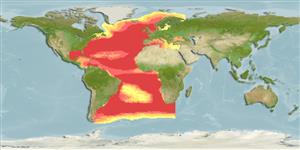Classificação / Names
Common names from other countries
Referência principal
Tamanho / Peso / Idade
Max length : 458 cm TL macho/indeterminado; (Ref. 26340); common length : 200 cm FL macho/indeterminado; (Ref. 168); Peso máx. publicado: 684.0 kg (Ref. 26340); Idade máx. registada: 32 anos (Ref. 5810)
Length at first maturity
Lm ?, range 97 - 110 cm
Ambiente
; marinhas; estuarina; oceanódromo (Ref. 51243); intervalo de profundidade 0 - 985 m (Ref. 55291), usually 0 - 100 m
Clima / Intervalo
Subtropical; 3°C - 30°C (Ref. 88796), preferred 26°C (Ref. 107945); 76°N - 58°S, 99°W - 42°E
Distribuição
Western Atlantic: Labrador and Newfoundland to Gulf of Mexico, and Caribbean Sea to Venezuela and Brazil. Eastern Atlantic: Lofoten Islands off Norway to Canary Islands, including the Mediterranean and the southern part of the Black Sea (Ref. 6769). Reported from Mauritania (Ref. 5377). There is a subpopulation off South Africa. Highly migratory species, Annex I of the 1982 Convention on the Law of the Sea (Ref. 26139).
Países | Áreas FAO | Ecossistemas | Ocorrências | Introduções
Descrição breve
Espinhos dorsais (total): 12 - 14; Raios dorsais moles (total): 13-15; Espinhos anais 0; Raios anais moles: 13 - 16; Vértebras: 39. A very large species, deepest near the middle of the first dorsal fin base. The second dorsal fin higher than the first; the pectoral fins are very short, less than 80% of head length. Swim bladder present. Lower sides and belly silvery white with colorless transverse lines alternated with rows of colorless dots. The first dorsal fin is yellow or bluish; the second reddish-brown; the anal fin and finlets dusky yellow and edged with black; the median caudal keel is black in adults. May be confused with several other tunas, these are typically much smaller and easily distinguished by specific patterns of stripes, bands or dots.
Categoria na Lista Vermelha da IUCN (Ref. 115185)
Ameaça para o homem
Harmless
Utilização humana
Pescarias: espécies comerciais; Aquacultura: espécies comerciais; peixe desportivo: sim
Ferramentas
Relatórios especiais
Descarregue XML
Fontes da internet
Estimates of some properties based on models
Phylogenetic diversity index
PD50 = 0.5039 many relatives (e.g. carps) 0.5 - 2.0 few relatives (e.g. lungfishes)
Nível Trófico
4.5 ±0.8 se; Based on diet studies.
Resiliência
Baixo, tempo mínimo de duplicação da população 4,5 - 14 anos (K=0.05-0.06; tm=3-5; tmax=15; Fec=10 million)
Vulnerabilidade
Very high vulnerability (82 of 100)
Categoria de preço
